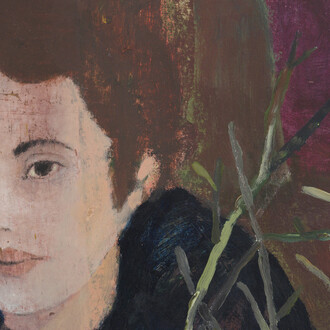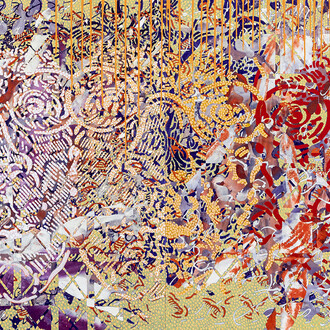Perrotin is pleased to present Emptinesses, the fourth solo exhibition by Chiho Aoshima with the gallery. For this new exhibition, Chiho Aoshima has developed a universe that combines traditional Japanese references, memories of manga, science fiction, a love of nature and somewhat ambiguous female representations. Oscillating between romanticism and futuristic projections, the boundaries between reality and fantasy become increasingly blurred...
Through ceramics, watercolours and acrylic on canvas, the artist, who was born in Tokyo in 1974, is continuing a cycle that currently focuses mainly on female figures, having abandoned zombies and skulls. One of the paintings in the exhibition, Act with Caution on a Full Moon Day!, 2024, shows a green mountainous landscape transformed into a face with long hair, evoking notions of animism. In the background, a sexy naked figure plays with rabbits whilst attempting to tame her long mane– a kind of Ophelia 2.0, about the painting by the Pre-Raphaelite artist John Everett Millais. This link can easily be made with the work of Chiho Aoshima, who admires Odilon Redon, a French contemporary of the British painter and the author of a dark romanticism tinged with strangeness and otherworldliness.
I was very young when I first felt the thrill of leafing through art books about Redon, but he remains my favourite artist to this day. I love his vision of the world, his exquisite colours, his sad eyes and the fact that he expresses things that are not visible to the naked eye...”
(Chiho Aoshima)
The painting can also be read as depicting several generations – the young girl and the mature lady with her curled up fingers – and if we continue to delve into the history of art, as a contemporary and very personal version of Gustav Klimt’s Three Ages of Woman (1905). Or an allegory of the temptress witch, faced with a naïve ingenue... The intoxicating piece from Death and the Maiden, a quartet by Franz Schubert, also springs to mind, which was written in 1824 and used in Jane Campion’s film Portrait of a Lady in 1996.
Representing these multiple figures of girls and women is a way for Chiho Aoshima to express her own emotions without committing herself to a cause. She is increasingly exploring this through the medium of ceramics, depicting small figures midway between fairies and geisha, or more mysterious apparitions, reminiscent of the Shinto religion, always with a very sensual link to the natural elements. Utagawa Kuniyoshi and Tsukioka Yoshitoshi are often mentioned as possible cultural Japanese influences.
Commentary on her work has also focused on her interest in antiquities, cemeteries and ruins, in which she sees a mystical dimension, but also a spatial projection of an almost third kind. In a text by Katy Siegel, she said that the ruins of Angkor gave her the impression of “entering another dimension.” The kind of dimension that we imagine to be driven by the resurgence of disaster films, manga recounting post-apocalyptic projections or the danger of immanent ecological disasters.
Here again, the artist takes a restrained approach to the subject, not actively engaging in the environmental debate, but still expressing her intimate and personal relationship with the cosmos. “When I moved from Tokyo to Kyoto, I was moved by the fact that you could see the sky wide open... Here, I can admire the mountains close by and I can see that, every day, this view is conditioned by the presence or absence of clouds. But it seems to me that there must have been more beautiful landscapes and skies in the past...” She hints at a nostalgia which never subsumes her, but which lends a timeless poetry to her work. Lately, ceramics, which she makes directly in her studio or in Shigaraki for the larger pieces, have become increasingly important. As in the early days of her career, the general theme is the coexistence of humans and nature.
Breaking down the ever-diminishing hierarchies between art and crafts, the artist does not shy away from developing her ideas through the production of vases. She places luminous flowers in them, as well as weeds and dried flowers. “The moment when my work and my plants merge makes me happy,” she says, bringing an emotionality, even a sentimental enthusiasm, to the ancestral art of ikebana. The regular practice of ceramics also leads Chiho Aoshima to be more accepting of the effects of chance and to rethink the notion of experience.
In her works on paper and canvas, this experience is pursued with a redoubled connection between the figure and nature, shaking up the directions of gravity and levitation. Flowers and their roots fly into the sky. Rhizomes break free. Tufts of grass are inhabited by a joyful colony of elves, haloed by a luminous sky and the flight of dragonflies.
These Odonata, signs of good fortune, could simultaneously be likened to drones and discreetly speak to us of surveillance... The vibrant, shaded colours, far removed from the Superflat of her beginnings, draw the viewer into her galaxy, which oscillates between fairy tales and anxious projections... It’s like a rejection of ordinary triviality, or what she calls “Riajuu” in Japanese, the feeling of fulfilment in the real world, which she has never been able to fully experience. Chiho Aoshima reflects a great deal on this time, which moves at a frenetic pace. Always with a style that whispers between poetry, false naivety, gentle eroticism, dynamism and mysticism, she asks herself questions:
I don’t want to forget respect for nature and life, which was dear to people in the past. However, with the progress of science and technology, many things have been elucidated, which is why I would like to become acquainted with the wonders of the universe before I die. I would also like to understand why, when we’re talking about somebody, there is a strong probability that they will appear or call us...
There is therefore an infinite narrative embodied in these seemingly harmless and innocuous female allegories...
(Text by Marie Maertens)
















